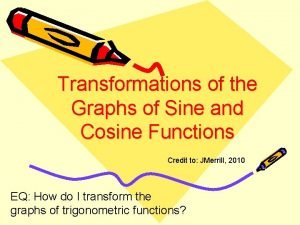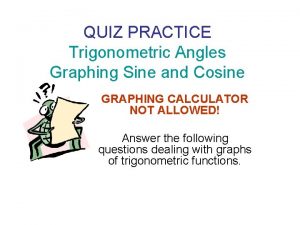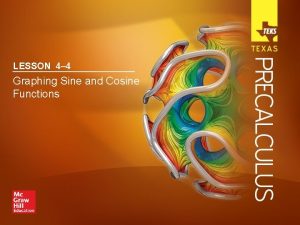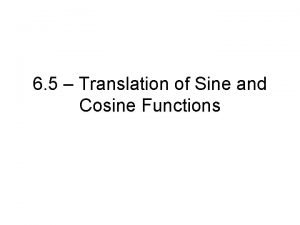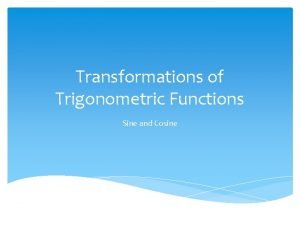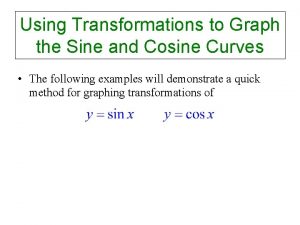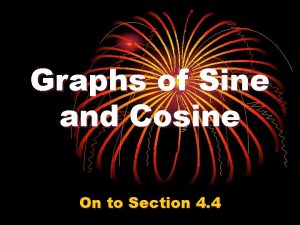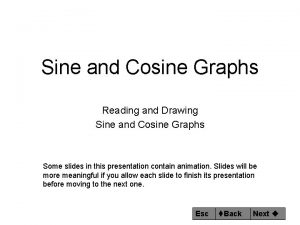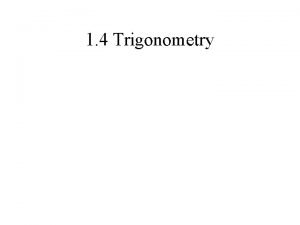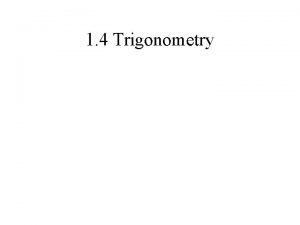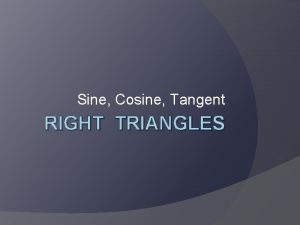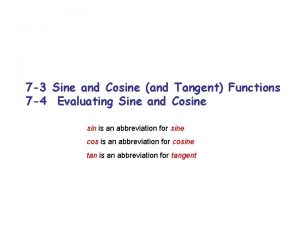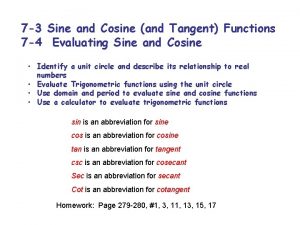7 2 THE SINE AND COSINE FUNCTIONS Functions







- Slides: 7

7. 2 THE SINE AND COSINE FUNCTIONS Functions Modeling Change: A Preparation for Calculus, 4 th Edition, 2011, Connally

Using Angles to Measure Position On a Circle Conventions For Working With Angles • We measure angles with respect to the horizontal, not the vertical, so that 0◦ describes the 3 o’clock position. • Positive angles are measured in the counterclockwise direction, negative angles in the clockwise direction. • Large angles (greater than 360◦ or less than − 360◦) wrap around a circle more than once. Functions Modeling Change: A Preparation for Calculus, 4 th Edition, 2011, Connally

Height on the Ferris Wheel as a Function of Angle Since we can measure position on the Ferris wheel using angles, we see that the height above the ground is a function of the angle position on the wheel. We can rewrite our table giving heights as a function of angle, instead of time. Your height above ground, y, as a function of the angle turned through by the wheel θ (degrees) f(t) (feet) -90° 0° 90° 180° 270° 360° 450° 540° 0 225 450 225 630° 720° 810° 900° 0 225 450 225 990° 1080° 1170° 1260° 1350° 0 225 450 225 0 Recall how the y-values repeat every 30 minutes. Similarly, in the Table, the values of y repeat every 360◦. In both cases, the y-values repeat every time the wheel completes one full revolution. Functions Modeling Change: A Preparation for Calculus, 4 th Edition, 2011, Connally

The Unit Circle We begin here with a special “starting” circle. This is the unit circle, the circle of radius one centered at the origin. The unit circle gets its name from the fact that its radius measures exactly one unit. (0, 1) Radius is 1 (-1, 0) P = (x, y) θ (0, 0) (1, 0) Origin (0, -1) Functions Modeling Change: A Preparation for Calculus, 4 th Edition, 2011, Connally

The Sine and Cosine Functions Suppose P = (x, y) in the figure is the point on the unit circle specified by the angle θ. We define the functions, cosine of θ, or cos θ, and sine of θ, or sin θ, by cos θ = x and sin θ = y. In other words, cos θ is the x-coordinate of the point P; and sin θ is the ycoordinate. P = (x, y) y = sin(θ) θ x = cos(θ) Unit Circle Functions Modeling Change: A Preparation for Calculus, 4 th Edition, 2011, Connally

Values of the Sine and Cosine Functions Example 2 Find the values of sin θ and cos θ for θ = 0◦, 90◦, 180◦, 270◦. Solution We can find the values of sin θ and cos θ for the angles as follows: • At θ = 0◦, P = (1, 0) so cos 0◦ = 1 and sin 0◦ = 0 • At θ = 90◦, P = (0, 1) so cos 90◦ = 0 and sin 90◦ = 1 • At θ = 180◦, P = (− 1, 0) so cos 180◦ = − 1 and sin 180◦ = 0 • At θ = 270◦, P = (0, − 1) so cos 270◦ = 0 and sin 270◦ = − 1. Functions Modeling Change: A Preparation for Calculus, 4 th Edition, 2011, Connally

The Sine and Cosine Functions In Right Triangles If θ is an angle in a right triangle (other than the right angle), sin θ = Opposite/Hypotenuse cos θ = Adjacent/Hypotenuse Consider the right triangle formed in the circle of radius r in the Figure: Hypotenuse: r = Radius P = (x, y) Opposite: y θ Adjacent: x sin θ = y/r cos θ = x/r Functions Modeling Change: A Preparation for Calculus, 4 th Edition, 2011, Connally
